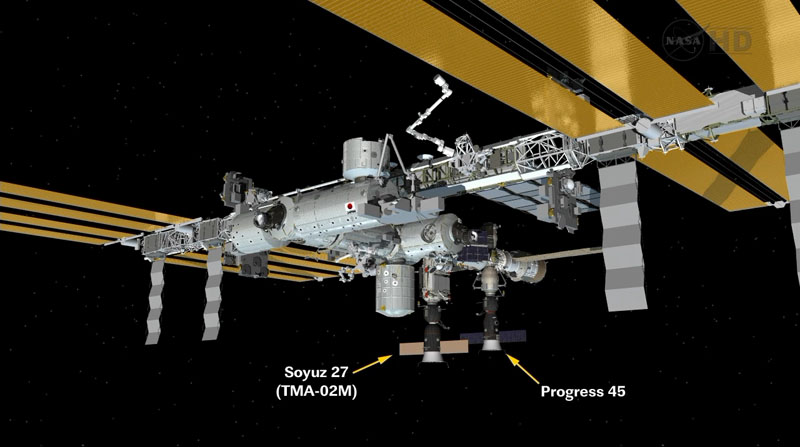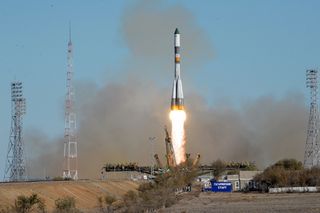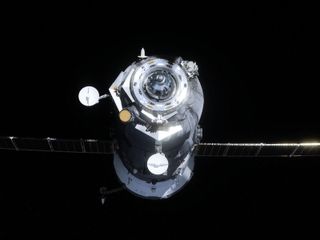New Robot Russian Cargo Ship Docks at Space Station

An unmanned Russian cargo ship pulled up to the International Space Station today (Nov. 2) carrying tons of fresh supplies for the orbiting lab's three-man crew in the first successfully delivery mission since an August rocket crash.
The robotic Progress 45 spacecraft docked at the space station at 7:41 a.m. EDT (1141 GMT), ending a three-day trip that began with a smooth Sunday launch from Baikonur Cosmodrome in Kazakhstan atop a Russian-built Soyuz rocket. By coincidence, the cargo ship docked on the 11th anniversary of the arrival of the first space station crew, Expedition 1, in 2000, a mission that began the station's unbroken streak of a continued human presence in space.
The supplies aboard Progress 45 include 1,635 pounds (741 kilograms) of propellant for the space station's thrusters, 110 pounds (nearly 50 kg) of oxygen, 926 pounds (420 kg) of water and 3,108 pounds (1,409 kg) of other gear such as spare parts, maintenance equipment and experiment supplies.
The mission is Russia's first successful flight of a Progress cargo ship since an Aug. 24 Soyuz rocket crash that destroyed the Progress 44 cargo ship due to a gas generator malfunction in the rocket's third stage. The Soyuz and Progress 44 spaceship crashed in Siberia, Russian space officials said.

An investigation into the crash found that contamination in a gas generator fuel line or valve was the most likely cause of the crash. The malfunction was a rare failure in Russia's typically dependable Soyuz boosters. [Photos: Russia's Lost Cargo Ship Progress 44]
"After the accident during the launch of a Progress cargo vehicle a couple months ago, there's been some uncertainty in the program," NASA astronaut Mike Fossum said from the space station after the Progress 45's successful launch. "This is a really huge step. This helps clear the rocket of any underlying problems, and so the next Soyuz crew has already gone to Baikonur."
The successful Progress 45 mission paves the way for a planned late-night Nov. 13 launch of three new space station crewmembers aboard a Soyuz rocket similar to that used to launch the robotic Progress spacecraft. Russia's Federal Space Agency had delayed the launch of the station's new crew to make sure its Soyuz rockets were safe for manned launches.
Get the Space.com Newsletter
Breaking space news, the latest updates on rocket launches, skywatching events and more!
That delay in regular crew launches forced the space station to drop from its full six-person crew size down to a three-man staff. Space station managers also discussed the possibility of leaving the space station without a crew, if it became necessary.
The station's current crew — NASA astronaut Mike Fossum, Russian cosmonaut Sergei Volkov and Japanese astronaut Satoshi Furukawa —will return to Earth on Nov. 22 after handing control of the orbiting lab over to their replacements riding up on the Nov. 14 Soyuz launch.
Another three-person crew will launch in December, space station officials have said.
"The December Soyuz mission will restore the space station crew size to six and continue normal crew rotations," Bill Gerstenmaier, NASA's associate administrator for human exploration and operations, said in a statement Sunday after the Progress 45 launch.

The Progress 45 cargo ship parked at the Earth-facing Pirs docking port on the bottom of the space station. Another older cargo ship, called Progress 42, was previously docked there, but left the space station on Oct. 29 to make room for Progress 45, NASA officials said.
The first iPads to fly in space were also delivered to the space station crew by the Russian space freighter.
Russian space officials packed the two Apple iPads on the Progress 45 cargo ship as entertainment tablets for the space station crew. They are the first tablets of their kind ever sent to the space station, space station officials have said.
The iPads join iPod music players and iPhone 4 devices already on the space station. The iPhone 4 devices were delivered by NASA space shuttle astronauts earlier this year and are loaded with an app to help astronauts perform experiments.
The next spacecraft to launch toward the space station will be the Soyuz TMA-21 spacecraft carrying NASA astronaut Dan Burbank and Russian cosmonauts Anatoly Ivanishin and Anton Shkaplerov. Liftoff is set for 11:14 p.m. EST on Nov. 13 (0414 GMT on Nov. 14).
You can follow SPACE.com Managing Editor Tariq Malik on Twitter @tariqjmalik. Follow SPACE.com for the latest in space science and exploration news on Twitter @Spacedotcom and on Facebook.
Join our Space Forums to keep talking space on the latest missions, night sky and more! And if you have a news tip, correction or comment, let us know at: community@space.com.

Tariq is the Editor-in-Chief of Space.com and joined the team in 2001, first as an intern and staff writer, and later as an editor. He covers human spaceflight, exploration and space science, as well as skywatching and entertainment. He became Space.com's Managing Editor in 2009 and Editor-in-Chief in 2019. Before joining Space.com, Tariq was a staff reporter for The Los Angeles Times covering education and city beats in La Habra, Fullerton and Huntington Beach. In October 2022, Tariq received the Harry Kolcum Award for excellence in space reporting from the National Space Club Florida Committee. He is also an Eagle Scout (yes, he has the Space Exploration merit badge) and went to Space Camp four times as a kid and a fifth time as an adult. He has journalism degrees from the University of Southern California and New York University. You can find Tariq at Space.com and as the co-host to the This Week In Space podcast with space historian Rod Pyle on the TWiT network. To see his latest project, you can follow Tariq on Twitter @tariqjmalik.











